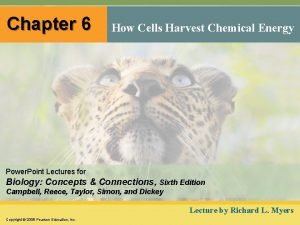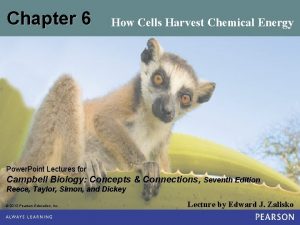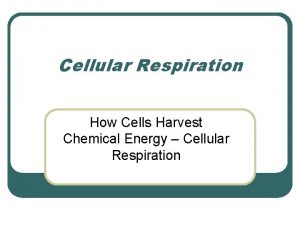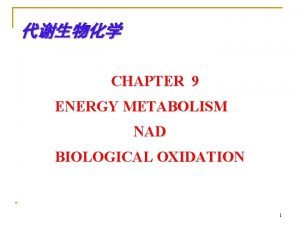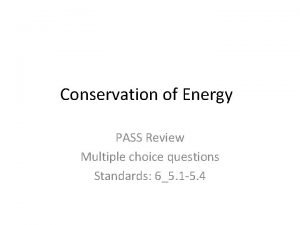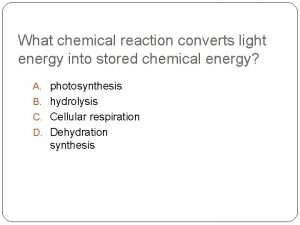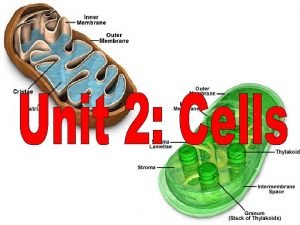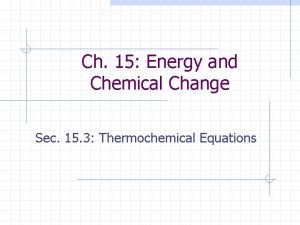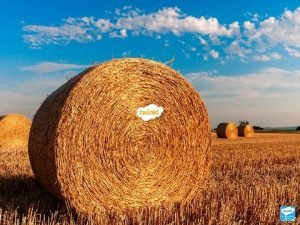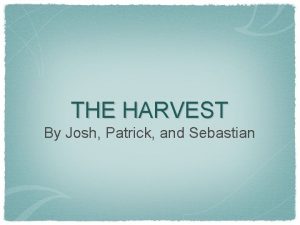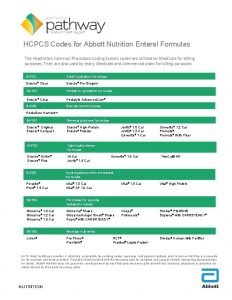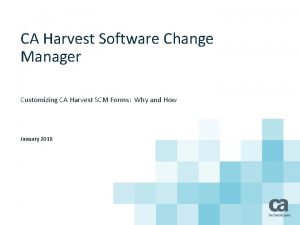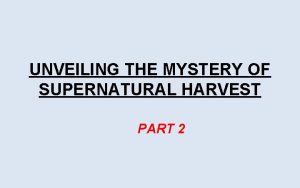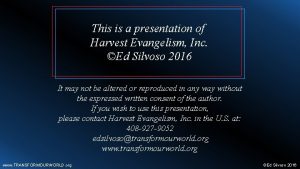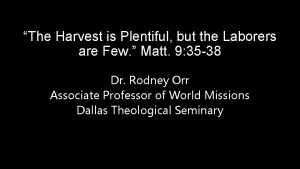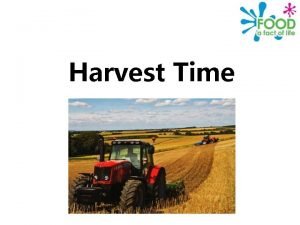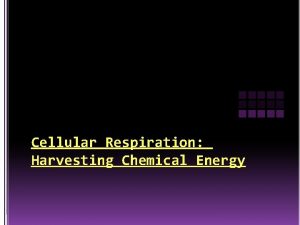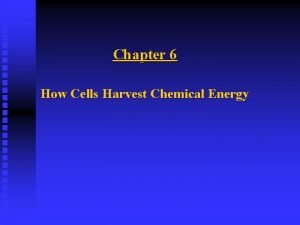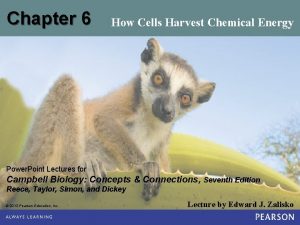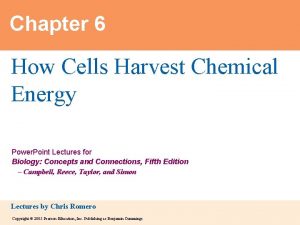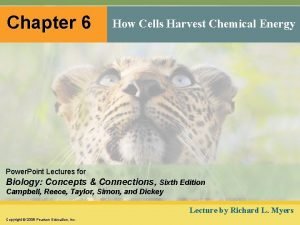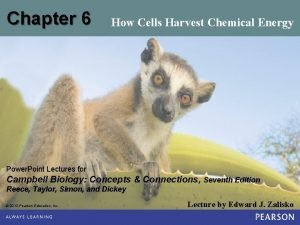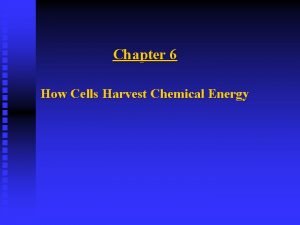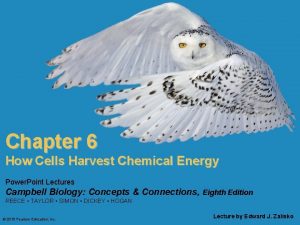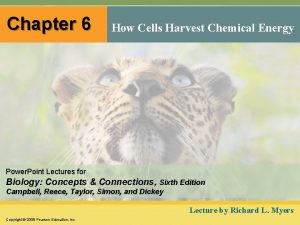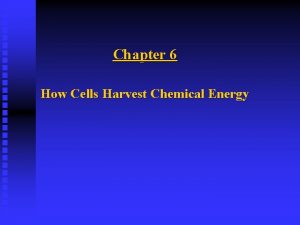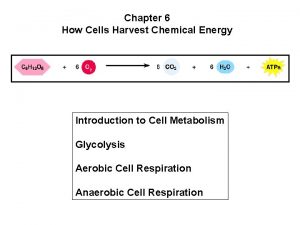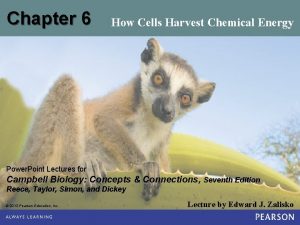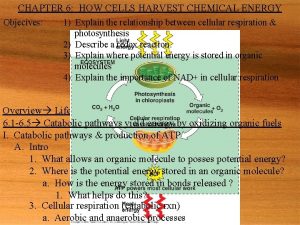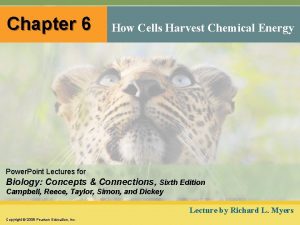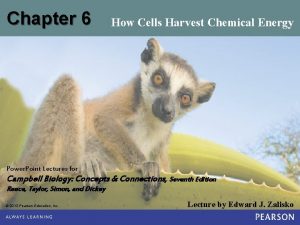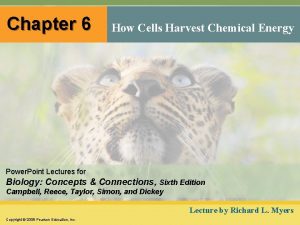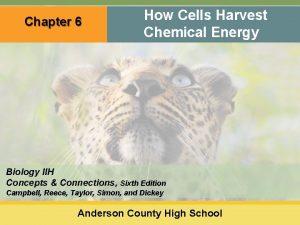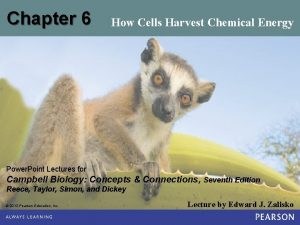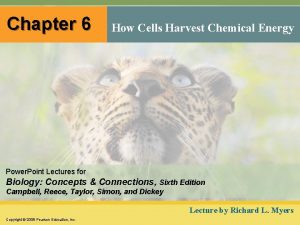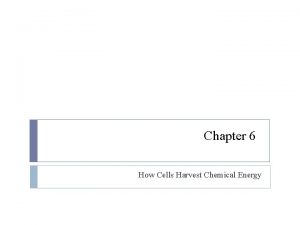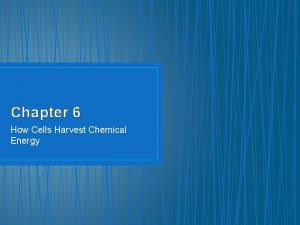Chapter 6 How Cells Harvest Chemical Energy 0














































- Slides: 46

Chapter 6 How Cells Harvest Chemical Energy 0

0 How Is a Marathoner Different from a Sprinter? • Human muscles contain two different types of muscle fibers that perform differently under different conditions • The ratio of types of fibers is determined genetically and cannot be converted from one type to another.

0 • The different types of muscle fibers function either aerobically, with oxygen, or anaerobically, without oxygen. • The slow muscle fibers are muscle cells that can sustain repeated, long contractions but don’t generate a lot of quick power for the body. • Fast fibers are better able to produce ATP anaerobically • Cellular respiration o Is the process by which cells produce energy aerobically

INTRODUCTION TO CELLULAR RESPIRATION 0 6. 1 Photosynthesis and cellular respiration provide energy for life • In photosynthesis, which occurs in the chloroplast, the energy of sunlight is used to rearrange the atoms of CO 2 and H 2 O to produce glucose and O 2. • In cellular respiration, which occurs in the mitochondria, O 2 is consumed as glucose is broken down to CO 2 and H 2 O. • The CO 2 and H 2 O released by cellular respiration are converted through photosynthesis to glucose and O 2, which are then used in respiration.

0 • The processes of photosynthesis and cellular respiration are complementary. During these energy conversions, some energy is lost in the form of heat. • Photosynthesis uses solar energy to produce glucose and O 2 from CO 2 and H 2 O Sunlight energy ECOSYSTEM Photosynthesis in chloroplasts Glucose CO 2 H 2 O O 2 Cellular respiration in mitochondria ATP (for cellular work) Heat energy Figure 6. 1

0 6. 2 Breathing supplies oxygen to our cells and removes carbon dioxide • Breathing provides for the exchange of O 2 and CO 2 between an organism and its environment • Respiration is gas exchange, and cellular respiration produces ATP. O 2 CO 2 Breathing Lungs CO 2 Bloodstream O 2 Muscle cells carrying out Cellular Respiration Glucose O 2 Figure 6. 2 CO 2 H 2 O ATP

0 6. 3 Cellular respiration banks energy in ATP molecules • Cellular respiration breaks down glucose molecules and banks their energy in ATP C 6 H 12 O 6 Glucose + O 2 6 CO 2 Oxygen gas Carbon dioxide 6 Figure 6. 3 + 6 H 2 O Water + ATPs Energy

• Cellular respiration: o Consumes glucose. o Produces water. o Produces carbon dioxide. o Releases heat. o Is accomplished by many steps.

CONNECTION 0 6. 4 The human body uses energy from ATP for all its activities • ATP powers almost all cellular and body activities Table 6. 4

• Humans use the calories they obtain from food as their source of energy. • Humans use about 75% of their daily calories for involuntary life-sustaining activities such as digestion, circulation, and breathing.

0 6. 5 Cells tap energy from electrons “falling” from organic fuels to oxygen • During cellular respiration, the energy in glucose is carried by electrons. • Electrons lose potential energy during their transfer from organic compounds to oxygen • Oxidation is the loss of electrons, and reduction is the gain of electrons.

0 • When glucose is converted to carbon dioxide it loses hydrogen atoms, which are added to oxygen, producing water Loss of hydrogen atoms (oxidation) C 6 H 12 O + 6 O 2 6 Glucose 6 CO 2 + 6 H 2 O + Energy (ATP) Gain of hydrogen atoms (reduction) Figure 6. 5 A

0 • In biological systems, dehydrogenase is an important enzyme involved in the regulation of redox reactions. • Dehydrogenase removes electrons (in hydrogen atoms) from fuel molecules (oxidation) and transfers them to NAD+ (reduction) H O NAD+ _ + 2 H 2 H+ Figure 6. 5 B Oxidation Dehydrogenase H + 2 e Reduction O + 2 H NADH (carries 2 electrons) + H

0 • NADH passes electrons to an electron transport chain • As electrons “fall” from carrier to carrier and finally to O 2 energy is released in small quantities NADH ATP NAD 2 e Controlled release of energy for synthesis of ATP H Electron transport chain 2 e 2 H Figure 6. 5 C H 2 O 1 2 O 2

STAGES OF CELLULAR RESPIRATION AND FERMENTATION • 6. 6 Overview: Cellular respiration occurs in three main stages • Cellular respiration o Occurs in three main stages 0

Do Now • What are three stages of cellular respiration?

0 • Stage 1: Glycolysis o Occurs in the cytoplasm o Breaks down glucose into pyruvate, producing a small amount of ATP

0 • Stage 2: The citric acid cycle o Takes place in the mitochondrial matrix o Completes the breakdown of glucose, producing a small amount of ATP o Supplies the third stage of cellular respiration with electrons

0 • Stage 3: Oxidative phosphorylation o Occurs in the mitochondria o Uses the energy released by “falling” electrons to pump H+ across a membrane o Harnesses the energy of the H+ gradient through chemiosmosis, producing ATP

0 • http: //www. youtube. com/watch? v=Adt. Au 5 Jg. OV 0&feature=related NADH High-energy electrons carried by NADH FADH 2 and GLYCOLYSIS Glucose Pyruvate OXIDATIVE PHOSPHORYLATION (Electron Transport and Chemiosmosis) CITRIC ACID CYCLE Mitochondrion Cytoplasm ATP Figure 6. 6 Substrate-level phosphorylation CO 2 ATP CO 2 Substrate-level phosphorylation ATP Oxidative phosphorylation

6. 7 Glycolysis harvests chemical energy by oxidizing glucose to pyruvate • “Splitting of sugar” • Glycolysis is the universal energy-harvesting process of life.

0 • In glycolysis, ATP is used to prime a glucose molecule which is split into two molecules of pyruvate 2 2 NAD+ NADH + 2 H Glucose 2 Pyruvate 2 ADP Figure 6. 7 A +2 P 2 ATP

0 • Glycolysis produces ATP by substrate-level phosphorylation in which a phosphate group is transferred from an organic molecule to ADP Enzyme P P P Adenosine ADP ATP P Organic molecule (substrate) Figure 6. 7 B P

• In the first phase of glycolysis, ATP is used to energize a glucose molecule, which is then split in two small sugars that are now primed to release energy. Steps – 1 A 3 fuel molecule is energized, using ATP. Glucose ATP PREPARATORY PHASE (energy investment) Step 1 ADP P Glucose-6 -phosphate P Fructose-1, 6 -diphosphate 2 ATP 3 ADP P Step A 4 six-carbon intermediate splits into two three-carbon intermediates. Figure 6. 7 C 4

• In the second phase of glycolysis ATP, NADH, and pyruvate are formed P Step A 5 redox reaction generates 6 9 NADH. P NAD 5 5 NAD P 6 NADH +H ADP P P 1, 3 -Diphosphoglycerate 6 7 6 ATP P P 7 P 8 8 H 2 O 7 P 3 -Phosphoglycerate 7 8 2 -Phosphoglycerate 8 H 2 O P P 9 ADP Phosphoenolpyruvate (PEP) 9 ADP 9 Figure 6. 7 C 6 ADP ATP ENERGY PAYOFF PHASE P +H P P Steps – 6 9 ATP and pyruvate are produced. Glyceraldehyde-3 -phosphate (G 3 P) 9 ATP Pyruvate

Glycolysis Overview • The result of glycolysis is a conversion of glucose to two three-carbon compounds, that we call pyruvate. • The end products of glycolysis are ATP, NADH, and pyruvate. • Glycolysis Overview

6. 8 Pyruvate is chemically groomed for the citric acid cycle • Prior to the citric acid cycle, enzymes process pyruvate, releasing CO 2 and producing NADH and acetyl Co. A NADH H NAD 2 Co. A Pyruvate 1 3 CO 2 Figure 6. 8 Coenzyme A Acetyl Co. A (acetyl coenzyme A)

Transition • Between glycolysis and the citric acid cycle, pyruvate is oxidized (loses electrons) while a molecule of NAD+ is reduced (gains electrons) to NADH.

0 6. 9 The citric acid cycle completes the oxidation of organic fuel, generating many NADH and FADH 2 molecules • In the citric acid cycle, the two-carbon acetyl part of acetyl Co. A is oxidized Acetyl Co. A CITRIC ACID CYCLE 2 CO 2 3 NAD FADH 2 3 NADH FAD 3 H Figure 6. 9 A ATP ADP P

0 • The two carbons are added to a four-carbon compound, forming citrate o Which is then degraded back to the starting compound

• For each turn of the cycle o Two CO 2 molecules are released o The energy yield is one ATP, three NADH, and one FADH 2 Co. A Acetyl Co. A 2 carbons enter cycle Oxaloacetate NADH 1 Citrate H NAD 5 CO 2 leaves cycle 2 CITRIC ACID CYCLE NAD Malate NADH ADP FADH 2 4 P ATP FAD H Alpha-ketoglutarate 3 CO 2 leaves cycle Succinate NADH Step 1 Acetyl Co. A stokes the furnace. Figure 6. 9 B Steps 2 and NAD H 3 NADH, ATP, and CO 2 are generated during redox reactions. Steps 4 and 5 Redox reactions generate FADH 2 and NADH.

Citric Acid Cycle • The enzymes of the citric acid cycle are located in the mitochondrial matrix. • At the end of the citric acid cycle, most of the energy remaining from the original glucose is stored in NADH. • Citric Acid Cycle

0 6. 10 Most ATP production occurs by oxidative phosphorylation • Electrons from NADH and FADH 2 o Travel down the electron transport chain to oxygen, which picks up H+ to form water • Energy released by the redox reactions o Is used to pump H+ into the space between the mitochondrial membranes o Overview o http: //www. youtube. com/watch? v=KXsx. JNXa. T 7 w&feature=related

0 • In chemiosmosis, the H+ diffuses back through the inner membrane through ATP synthase complexes driving the synthesis of ATP. • In the electron transport chain, the final electron acceptor is an oxygen atom. • Electron Transport Chain H+ Intermembrane space . Protein complex H+ H+ FADH 2 Electron flow FAD 1 O 2 + 2 H+ H+ H+ H 2 O Electron Transport Chain OXIDATIVE PHOSPHORYLATION Figure 6. 10 ATP H+ synthase H+ NADH H+ H+ Electron carrier Inner mitochondrial membrane Mitochondrial matrix H+ H+ ADP P ATP H+ Chemiosmosis

CONNECTION 6. 11 Certain poisons interrupt critical events in cellular respiration • Various poisons o Block the movement of electrons o o Block the flow of H+ through ATP synthase Allow H+ to leak through the membrane • Rotenone is a poison commonly added to insecticides. Insects exposed to rotenone will die because of inadequate ATP production. Figure 6. 11 0

Cyanide, carbon monoxide Rotenone H+ H+ H+ Oligomycin H+ ATP Synthase H+ H+ H+ DNP FADH 2 1 NADH NAD+ O 2 2 H+ H+ H 2 O ADP P H+ Electron Transport Chain Chemiosmosis ATP

0 6. 12 Review: Each molecule of glucose yields many molecules of ATP • Oxidative phosphorylation, using electron transport and chemiosmosis o Produces up to 38 ATP molecules for each glucose molecule that enters cellular respiration Electron shuttle across membrane Cytoplasm Mitochondrion 2 NADH (or 2 FADH 2) 2 NADH GLYCOLYSIS 2 Glucose Pyruvate 2 Acetyl Co. A 2 ATP by substrate-level phosphorylation CITRIC ACID CYCLE 2 ATP by substrate-level phosphorylation Maximum per glucose: Figure 6. 12 6 NADH About 38 ATP 2 FADH 2 OXIDATIVE PHOSPHORYLATION (Electron Transport and Chemiosmosis) about 34 ATP by oxidative phosphorylation

Review • Glycolysis and the citric acid cycle must occur two times per glucose molecule. • The energy yield from the complete aerobic breakdown of a single molecule of glucose can vary with the mechanism used to shuttle NADH electrons into the mitochondrion. • http: //www. youtube. com/watch? v=Adt. Au 5 Jg. OV 0&feature=related • http: //www. youtube. com/watch? v=k. N 5 Mtq. AB_Yc

0 6. 13 Fermentation is an anaerobic alternative to cellular respiration • Cellular respiration produces the most ATP per molecule of glucose oxidized. • Under anaerobic conditions, many kinds of cells o Can use glycolysis alone to produce small amounts of ATP

0 • In lactic acid fermentation NADH is oxidized to NAD+ as pyruvate is reduced to lactate • Found in muscle cells and food products. 2 NADH 2 NAD GLYCOLYSIS Glucose 2 ADP 2 Figure 6. 13 A P 2 ATP 2 Pyruvate 2 Lactate

0 • In alcohol fermentation, NADH is oxidized to NAD+ while converting pyruvate to CO 2 and ethanol • Used in brewing, baking, and winemaking. 2 NAD 2 2 NADH 2 NAD GLYCOLYSIS 2 ADP 2 Glucose P 2 2 ATP CO 2 released 2 Ethanol 2 Pyruvate Figure 6. 13 B Figure 6. 13 C

• Strict Anaerobes-require anaerobic conditions and are poisoned by oxygen. • Facultative Anaerobe-can make ATP either by fermentation or oxidative phosphorylation, depending on whether O 2 is available. • http: //www. youtube. com/watch? v=y_k 8 x. Lr. B Ufg • http: //www. youtube. com/watch? v=t. Nqf. Ps. VAd. Yk &feature=fvw

INTERCONNECTIONS BETWEEN MOLECULAR BREAKDOWN AND SYNTHESIS 0 • 6. 14 Cells use many kinds of organic molecules as fuel for cellular respiration

0 • Carbohydrates, fats, and proteins can all fuel cellular respiration when they are converted to molecules that enter glycolysis or the citric acid cycle • Fats yield the most ATP. Food, such as peanuts Carbohydrates Sugars Fats Proteins Glycerol Fatty acids Amino groups Glucose G 3 P Pyruvate GLYCOLYSIS Figure 6. 14 Acetyl Co. A ATP CITRIC ACID CYCLE OXIDATIVE PHOSPHORYLATION (Electron Transport and Chemiosmosis)

0 6. 15 Food molecules provide raw materials for biosynthesis • Cells use some food molecules and intermediates from glycolysis and the citric acid cycle as raw materials • Biosynthesis consumes ATP needed to drive biosynthesis ATP CITRIC ACID CYCLE GLUCOSE SYNTHESIS Acetyl Co. A Pyruvate G 3 P Glucose Amino groups Amino acids Proteins Fatty acids Glycerol Fats Cells, tissues, organisms Figure 6. 15 Sugars Carbohydrates

0 6. 16 The fuel for respiration ultimately comes from photosynthesis • All organisms o Can harvest energy from organic molecules • Plants, but not animals o Can also make these molecules from inorganic sources by the process of photosynthesis Figure 6. 16
 Chapter 6 how cells harvest chemical energy
Chapter 6 how cells harvest chemical energy Chapter 6 how cells harvest chemical energy
Chapter 6 how cells harvest chemical energy How cells harvest chemical energy
How cells harvest chemical energy Nondisjunction in meiosis
Nondisjunction in meiosis Energy harvest
Energy harvest Waters view with open mouth
Waters view with open mouth Regulation of tubular reabsorption
Regulation of tubular reabsorption Pineal gland
Pineal gland How are somatic cells different from gametes
How are somatic cells different from gametes Somatic vs germ cells
Somatic vs germ cells Chlorocruorin
Chlorocruorin Eukaryotic cells vs prokaryotic
Eukaryotic cells vs prokaryotic Plant vs animal cell venn diagram
Plant vs animal cell venn diagram Prokaryotic cells vs eukaryotic cells venn diagram
Prokaryotic cells vs eukaryotic cells venn diagram The organelle trail
The organelle trail Masses of cells form and steal nutrients from healthy cells
Masses of cells form and steal nutrients from healthy cells Younger cells cuboidal older cells flattened
Younger cells cuboidal older cells flattened What cell type
What cell type Is a staphylococcus cell prokaryotic or eukaryotic
Is a staphylococcus cell prokaryotic or eukaryotic Cells and life lesson 1 answer key
Cells and life lesson 1 answer key As a roller coaster goes downhill
As a roller coaster goes downhill ________ converts light energy into chemical energy. *
________ converts light energy into chemical energy. * Energy example
Energy example Photosynthesis transforms light energy into chemical energy
Photosynthesis transforms light energy into chemical energy Chapter 4 cells and energy
Chapter 4 cells and energy Empirical formula pogil
Empirical formula pogil 7-1 practice problems chemistry answers
7-1 practice problems chemistry answers Chapter 18 chemical reactions balancing chemical equations
Chapter 18 chemical reactions balancing chemical equations Energy energy transfer and general energy analysis
Energy energy transfer and general energy analysis Energy energy transfer and general energy analysis
Energy energy transfer and general energy analysis Water vaporization equation
Water vaporization equation The stages of cellular respiration
The stages of cellular respiration Chapter 9 cellular respiration harvesting chemical energy
Chapter 9 cellular respiration harvesting chemical energy Chapter 9: cellular respiration: harvesting chemical energy
Chapter 9: cellular respiration: harvesting chemical energy When is harvest
When is harvest Wonder plot diagram
Wonder plot diagram Abbott enteral formulas
Abbott enteral formulas Moro moro props and costumes
Moro moro props and costumes Harvest software change manager
Harvest software change manager Don't judge each day by the harvest you reap
Don't judge each day by the harvest you reap Supernatural harvest
Supernatural harvest The law of the harvest
The law of the harvest Kingdom harvest alliance
Kingdom harvest alliance The feast of firstfruits
The feast of firstfruits Ipc personal goals
Ipc personal goals Harvest evangelism inc
Harvest evangelism inc The harvest is plentiful but the laborers are few
The harvest is plentiful but the laborers are few
